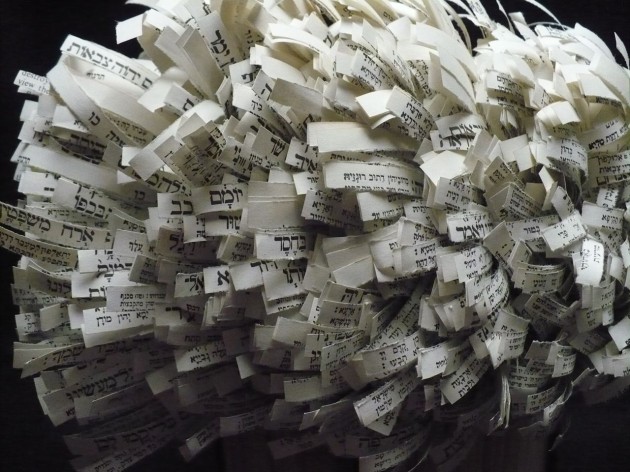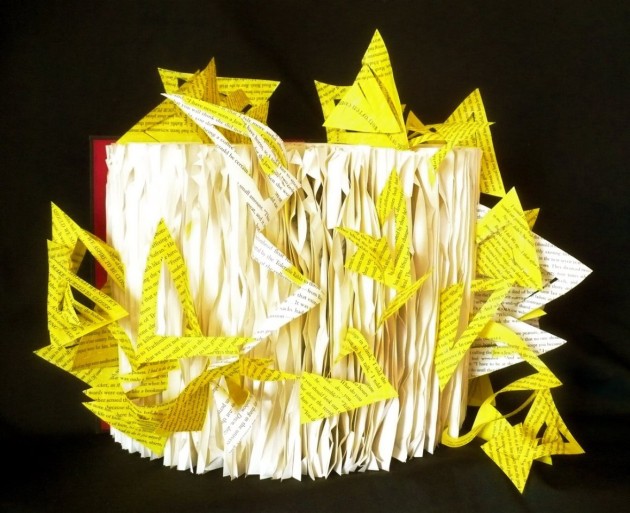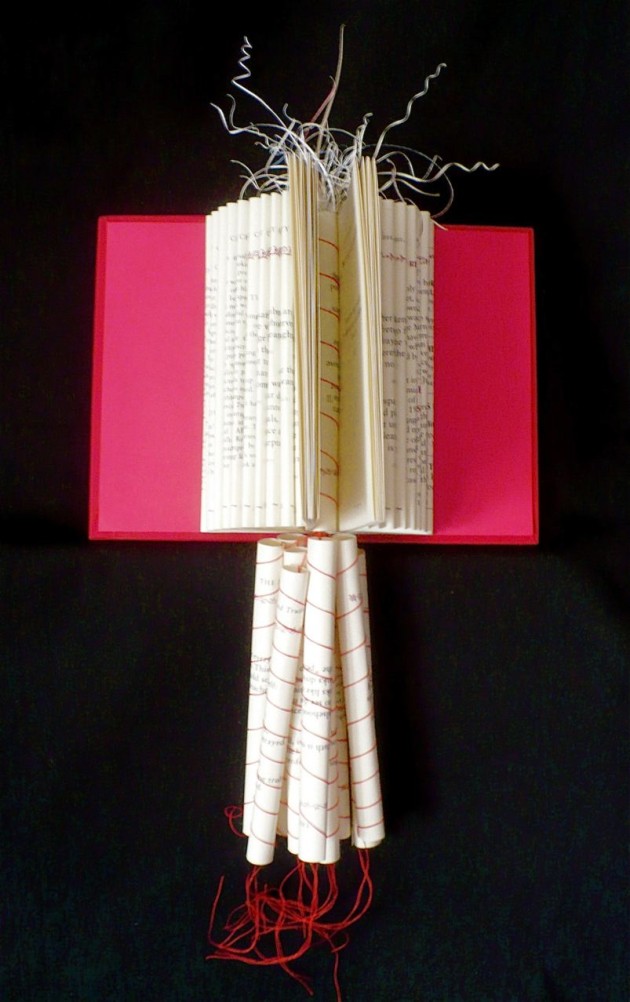
by Eleanor J. Bader
Eco-Conscious Book Destruction
New Jersey-based visual artist, Irmari Nacht, hates waste. An avid environmentalist, Nacht says her mission is to promote the recycling and re-purposing of everyday items rather than the cavalier disposal of goods deemed useless or unwanted.
Nacht’s glee is audible as she described converting old into new. In fact, her current project, turning discarded books into sculptures, is a case in point. Since 2007, Nacht has changed novels, poetry collections, prayer books, and non-fiction into statuary. The project is called Saved, and more than 30 books in the 106-piece series will be on display in Brooklyn’s majestic public library in Grand Army Plaza until April 5th.
Her artist’s statement explains her purpose: “The artwork, using the books as a metaphor, addresses environmental concerns, change, and transformation.” But it also does more than this. The visually stunning stand-alone books suggest whimsy as well as the more serious themes of displacement, racism, anti-Semitism, and hunger.
Jewish themes are especially prominent. One sculpture utilizes the biblical book of Isaiah, in Hebrew, and was created for a 2014 exhibition at London’s Wiener Library, the world’s oldest archive of Holocaust materials. “I was fascinated by the Hebrew letters,” Nacht told Lilith. “I think they’re very beautiful and the way I cut the book emphasizes the lettering. The fact that I could not read the words didn’t matter to me.”

Irmari Nacht’s “Books39Isaiah”
A second sculpture, using Jonathan Safran Foer’s 2002 novel Everything is Illuminated, was cut to suggest Jewish stars. The work also showcases Foer’s themes – including the emotional post-war return of a US-born grandson to his grandfather’s shtetl in eastern Poland – by somehow making the words Jew, Jewish, Jewishness, Rabbi, and Yiddish appear to jump from the book’s many folds. “I did not want the stars to be clean or bright so I cut them in a way to suggest displacement,” Nacht explains. “Just as the Jews were displaced during World War II, these stars are displaced.”

“Books103Illuminated”
Although Nacht says that she is not religiously observant, she adds that she has consistently been drawn to books with Jewish themes. “It must be subliminal. I pick them up not realizing they have anything to do with being Jewish, but something pulls me in,” she says.
One of her most recent sculptures transformed a tossed-aside copy of Rebbe Nachman of Breslov’s Finding Hope and Joy in Life: Timeless Wisdom from a Hasidic Master, and a future project will feature In Memory’s Kitchen: A Legacy from the Women of Terezin, a cookbook composed by residents of the Terezin Gestapo Police Prison in Czechoslovakia. “Terezin was purported to be the model, the ‘camp’ the Nazis showed off to the Red Cross,” Nacht says. “But people there were starving. Maybe it was fantasy, or maybe it was meant to test the women’s power of recall, but the internees wrote recipes on little scraps of paper. One of the authors entrusted the papers to a friend and told her, ‘If you survive, please get this to my daughter in Palestine.’ The handwritten recipes eventually found their way to the woman’s child and the book was published in 2006. I want to show some of the recipes. I also want the book to exude the spirit of hope, but I haven’t started this one yet. I’m waiting for the right moment.”

“Books107Empty”
Meanwhile, Nacht continues to work on other projects and continues to collect books for possible future use. Most of those she’s altered so far were purchased at the Englewood, New Jersey public library’s annual book sale. “The books I buy need to speak to me,” Nacht says, “but not in terms of content. What’s important to me is the form, the colors, the texture of the paper, the size and shape.”
Once she selects the books she’ll use, Nacht says that her technique varies. Sometimes pages are cut into slivers or strips. Other times they’re folded, cut into swirls or shapes, or pulled out. More often than not, the results look somewhat treelike. “Books are made of paper and paper comes from trees, so I guess I’m returning the books to their original form,” she laughs.
By this point in our interview, Nacht has come full circle, and again homes in on the necessity of environmental stewardship. “We’re falling apart here,” she quips.
In addition to promoting recycling and re-purposing through Saved, Nacht runs Nacht Associates, a more than 40-year-old public relations firm that has represented clients as disparate as the Bergen County Symphony Orchestra, Mercedes Benz, and the late Whitney Houston. “I like to do many different things throughout the day,” she says. “Sometimes I work on my art in the mornings, sometimes I work at night. I like to work when I feel like it, which is why I have always had my studio at home.”
Compartmentalizing, she says, is key. “My days are full: I’m a wife, a mother, a friend, a member of The Crones, a group of 19 women artists who’ve been meeting once a week for more than 20 years, as well as a sculptor and collage-maker.” That said, Nacht concedes that, for as long as she can remember, making art has been her first priority. “I always need to be creating,” she says. “Yes, showing my work is important and selling it is the pat on the back and the Good Housekeeping Seal of Approval. But first and foremost, I need to be making something.”
Irmari Nacht’s has been exhibiting her work in museums and galleries throughout the U.S. since 1978. Her sculpture and collage have been purchased by private individuals, museums, and corporations including Bowdoin College, the Cleveland Art Institute, the Jimmy Carter Museum, Rutgers University, the Yale Art Museum, Western Electric, PSE&G, and AT&T. Approximately one-third of the books in the SAVED series have been sold.